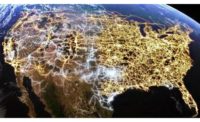A Conversation with Energy Visionary David Crane

David Crane visits a the Sunora solar manufacturing facility in Phoenix in 2013, when Crane was still president and CEO of NRG Energy.
Photo Courtesy of Getty Images.
Imagine a world in which Alexa, or a similar virtual home assistant, manages the energy in your home. She uses the power produced by your rooftop photovoltaic panels and the energy stored in your electric car batteries to make sure your home has enough energy. If necessary, she requests electricity from the grid — purchased from Amazon or Google, which sell their own excess renewable electricity at rock-bottom prices. If a storm is coming, she might disconnect your home grid from the overall grid and recommend a power reduction to keep you powered for the next few days.
It’s a world that David Crane, the former president and CEO of NRG Energy, imagines, and one he tried to move his former company toward. Crane wanted NRG to be the Apple, Google, Amazon or Facebook of electricity. He first convinced the company’s board of directors to begin decarbonizing the company’s power fleet, which had twice as much coal in the mix as the average electric company. Then he moved the company toward solar and tried to convince shareholders that NRG’s future was as a service company to help consumers produce their own electricity.
“As lack of confidence in the grid coincides with the introduction of new technologies, businesses and homeowners will realize that there is a better way. And, for them, that means generating most of the electricity they consume on the premises, from their own resources,” Crane wrote to shareholders in 2014.
Now Crane, who left the company in December 2015 after stock prices plunged, expects that it will be a private, tech-based entity such as Amazon, Google, Apple or Facebook filling the role of the utility of the future, not NRG or any other utility.
Crane’s instincts were right about a lot of things: coal power is dying; renewable power is the only source of energy experiencing double-digit growth; and states such as New York are moving to a more distributed grid, with utilities acting as service providers rather than providers of a commodity.
So why haven’t more utilities embraced similar changes?
One reason: some may not want to follow the path of Crane, who was pushed out of the company because his vision didn’t align with what shareholders wanted.
Secondly, utilities and regulators are too resistant to change, Crane said in a recent interview with ENR.
“Utility executives, they can all see this happening, but they would rather cling to the old system because the old system is a natural monopoly,” says Crane, who is now chief strategy officer and operating advisor to Pegasus Capital, a sustainability-oriented investment firm. “They would rather put it off for 10 or 20 years until they can retire.”
Additionally, he adds, public service commissions that regulate utilities don’t want to “go out on a limb and endorse radical competition or new technology. It’s an industry structure that is designed to be cautious and conservative to an extreme.”
Whether or not utilities are ready, corporate renewable energy purchases and electric vehicles (EVs) will push the electric grid to a more distributed energy model, he says.
As battery prices for EVs are decreasing, the impact of carbon emissions from cars with internal combustion engines is becoming more apparent, he says.
“Last year tailpipe emissions passed smokestack emissions. [EVs] are the biggest solution to the biggest part of the problem,” he says, as EVs can increase the demand for energy, and also be used to store more renewable energy.
Continued corporate purchases of renewable power will also change the electricity model.
Those two trends will result in the growth of behind-the-meter generation for homes, businesses and industry, and the burden of the keeping up the overall electric grid will fall to poorer families who can’t afford to build their own self-contained grid, he says.
What happens then is what has been called the utility death spiral, where fewer and fewer customers for the utility result in utilities raising rates, forcing more and more customers off the grid.
“I think that is definitely going to happen, but what happens is the death spiral doesn’t end in death, but sort of permanently handicapping the utilities,” Crane says. “I call it the post-office-ization of utilities, in the sense that if the post office was a private entity, no one would buy its stock. The business is in decline and they can never do anything to improve their cost structure. They [the utilities] don’t go away, they just become decidedly unattractive from an investment perspective.”
The U.S. grid, in its current form, will continue to exist as a backstop until it becomes too expensive to maintain, he says.
Though renewable prices are falling, and corporations are buying more renewable power, the timing of when the electric paradigm shift will happen is fuzzy to Crane.
“The evidence that things are changing still seems to be more anecdotal than systemic,” he says. “I’m still looking for that moment where we kind of leap into a viral pace of change.”
Related Article: How Engineers Help Navigate Renewables and Distributed Generation




